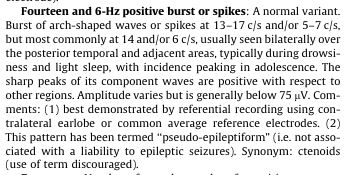The 6 Hz version of 14- and 6-Hz positive bursts
Jun 22, 2025The patient is five years old. These are best seen on referential montages, where they may be confused with a train of sharp waves or even electrographic seizures; hence they are regarded as "pseudo-epileptiform". As the name implies and as can be seen below, they are electropositive and predominantly appear most electropositive at over one of the mid-posterior temporal regions, with a large field that extends into the contralateral homologous regions. In the example below, the discharge is primarily electro positive at T4-T6
In the above, you will see that the discharges are very close to 6 Hz. On bipolar montages there are easily missed; see below, identifiable by the small red dots
In the bipolar AP montage below they also ;ow in amplitude, electropositive at T4-T6 and there are low amplitude sharp waves at T3. The 14- and 6-Hz positive bursts are physiologically normal in children and young adults, while the sharp waves at T3 represent inter-ictal epileptiform discharges.
The following is taken from the EEG glossary by Caine, 2017, kindly sent to me by Prof Roland Eastman






